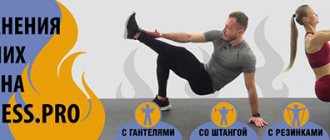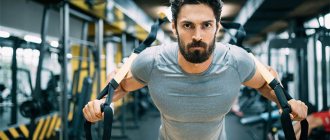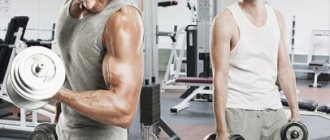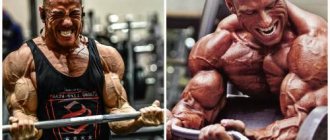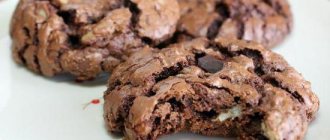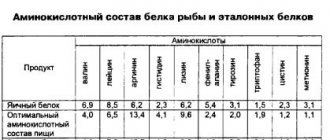In this article, you will learn how to distinguish a genetically gifted bodybuilder from an amateur, to whom nature has not given bonuses for the rapid development of a powerful bodybuilder's body.
This information will help you determine your genetics (good or bad), so that you already at the planning know all your pros and cons when doing bodybuilding.
Genetic predisposition to a particular sport is often a determining factor in becoming a champion in the professional arena.
When it comes to bodybuilding, unfortunately, only genetics will decide whether you become great (like Arnold Schwarzenegger or Ronnie Coleman) or not.
Even as a child, you probably noticed that one person is physically well developed, strong, from birth, while the other is weak, thin , with thin bones, with minimal muscle mass. And who do you think will achieve more success in bodybuilding, given the same training and nutrition? Of course the second one. This is the so-called genetic predisposition to bodybuilding, when a person’s body type, structure and attachment of muscles favors exercise with weights and iron.
Let us identify the decisive genetic factors that directly affect success in bodybuilding:
- Body type
- Muscle insertion point
- Neuromuscular connection
- Length of muscle belly
- Type and number of muscle fibers
- The body's response to anabolic steroids
- Character (personal qualities)
Now let's look at each factor in more detail.
Body types (somatotypes) of people
Each of us has our own body type, which directly affects the amount of subcutaneous fat and muscle, strength and structure .
In order to determine your somatotype , you need to measure your wrist circumference. As a rule, if the measurements show from 15 to 17.5 cm , then we can say that you have fragile and thin bones, if from 17.5 to 20 cm , then you have an average bone foundation, but what if your wrist circumference will be more than 20 cm , congratulations, you have a powerful and strong bone structure.
Also, in order to navigate your body type, sometimes it helps to measure your ankle (its circumference is almost always 5-6 cm smaller than the wrist in all people). Of course, there are exceptions, both in the direction of decrease, that is, with the same size of the ankle and wrist, in this case we can say that the strength of the top and bottom is the same, and in the direction of increase (by 10-12 cm), in this case, the strength of the lower part of the body is much greater than its upper part.
Depending on his nutritional system, training and recovery program, an athlete can change his body beyond recognition. However, for some it will be easy and not forced, but for others it will be very, very difficult. That is why (according to Sheldon ), it is customary to distinguish all people into the following body types:
- Mesomorph (muscular)
- Endomorph (plump)
- Ectomorph (thin)
We have already written in more detail about each body type in the article; if you are interested in reading, please follow this link.
Body types (somatotypes) of people
It is important to understand that if you cancel proper nutrition, recovery and regular training, you will end up where you started . In this case, endomorphs will benefit the most, because they need to strictly, strictly adhere to a sports lifestyle in order to maintain their figure at a high, athletic level.
Also, I would like to draw your attention to the following factors that relate to each specific body type.
Metabolism
People with a slow metabolism are usually fat and have a lot of excess weight, while fast digestion contributes to weight loss, it will be difficult for people to gain muscle mass.
Someone can eat a lot and not gain weight due to a fast metabolism, while someone can eat an extra bun or cake and immediately gain weight . In addition, athletes absorb substances useful for muscle growth, proteins, fats, carbohydrates, vitamins and minerals, differently.
Load response
We respond to training programs differently, for some it is enough to do the bench press 2 times for the chest to grow by leaps and bounds , and for others, even with a 5-day training of the pectoral muscles, they will not get results.
Everything is individual, much depends on restorative abilities and the athlete’s fitness level. However, do not confuse beginners and experienced athletes, for the former everything is very simple, the body will grow, up to a certain point, on a universal program, since the hidden capabilities of a beginner (potential for growth in strength and muscle mass) are still very far from the limit of human capabilities .
Muscle response to force load
Bone strength
At a certain training stage, your strength results can reach their apogee , which will be determined by the strength of your ligaments, cartilage, tendons, and bones; the main thing here is not to “break” and stop in time.
As the legendary Ronnie Coleman said, if you want huge muscles, then work with heavy weights, for a large number of repetitions. And as you understand, the more weight you put on the barbell and the more repetitions you can do, the larger your muscles .
Secret of success
Bad genetics can also influence it. Persistence, willpower, determination, a serious attitude to business and proper nutrition are the components of success. There are many examples of people with poor genetics achieving outstanding results. These examples can be seen both in professional sports and at the amateur level. Few people know that the current Mr. Olympia Phil Heath in his youth was skinny and too narrow in the shoulders. No amount of medication could make his shoulders broad and round. Many years of work were done, thanks to which the American achieved spherical deltas.
Genetics is not a death sentence, but just a reason to reconsider your attitude to training, recovery and nutrition.
If you are serious about achieving achievements in bodybuilding, then give it your all, feel like part of the “iron brotherhood”, don’t think about genetics and don’t listen to those who think you won’t succeed. That's what losers always say. And remember the great phrase of Arnold Schwarzenegger: “If my muscles say no, I answer them with a firm yes!” BLOG COMMENTS POWERED BY DISQUS
Muscle insertion point
The strength of a muscle, if we take into account the genetic makeup of a person, will depend directly on its points of attachment .
Due to the fact that the muscle is attached to two different bones, it can produce movement.
If the beginning of the muscle, in all people, as a rule, is always located in the same place (this point is called the “ beginning of the muscle ”), then with the point of attachment of the muscle to the bone, not everything is so simple.
The attachment point is the place where the muscle group attaches to the most mobile bone. Moreover, the further the attachment point is located from the joint, the more the athlete will be able to show muscle effort .
For clarity, let's look at the biceps . One end of it begins at the same place, near the shoulder, the other end, that is, where it is attached, ends on the forearm , since it is more mobile in relation to the humerus. Thanks to this connection with the bones, when the biceps contracts, movement occurs (the forearm is pulled towards the shoulder). Accordingly, people who naturally have a biceps attachment point as low on the forearm will have greater strength by nature, with any biceps lifts.
Origin and insertion of muscle
Genetically gifted athletes for strength sports always have muscle attachment points displaced In other words, if you take two athletes with arms of the same length and triceps of the same size, then the muscle force will show more, for example, in the French bench press exercise, an athlete whose triceps attachment point is shifted further from the joint .
Even the slightest displacement of muscle attachment points will bring significant superiority over an athlete whose points are located close to the joints.
How genetics affects strength
The most well-known gene that enhances physical performance is ACTN3, known as alpha-actinin-3. This gene is studied to identify predisposition to certain sports.
There are two types of alpha-actinin protein - ACTN2 and ACTN3. ACTN2 is found in all types of muscle fibers, and ACTN3 is found in type IIb - fast and large muscle fibers that are activated by short-term loads and develop greater force. ACTN3 is therefore associated with powerful force production.
Approximately 18% of people worldwide have ACTN3 deficiency. Their bodies produce more ACTN2 to compensate for the lack. These people cannot make explosive movements as quickly as those who have an abundance of this protein. For example, among elite sprinters there are no people with alpha-actinin-3 deficiency.
The angiotensin converting enzyme (ACE) gene is also involved in athletic performance. Increased frequency of the ACE D allele is associated with strong athletes and sprinters, while increased frequency of the ACE I allele is more common in athletes with impressive endurance.
One study Variable number of tandem repeat polymorphisms of the interleukin-1 receptor antagonist gene IL-1RN: a novel association with the athlete status. showed that physical development is also influenced by variants of the VNTR-1RN gene. This gene influences cytokines and enhances the inflammatory response and recovery processes after exercise.
Study Association of interleukin-15 protein and interleukin-15 receptor genetic variation with resistance exercise training responses. Reichman confirms these findings and links the cytokine interleukin-15 to increased muscle hypertrophy.
Neuromuscular efficiency
Neuromuscular efficiency will depend on how many muscle fibers are involved, it shows how efficiently the muscles respond to signals sent from the nervous system.
The more muscle fibers participate in the work, the more effective the exercise is. That is why athletes by nature with high neuromuscular efficiency train much more productively in the gym, showing, under equal conditions, higher strength indicators .
How genetics affects muscle growth
Number of satellite cells
4.bp.blogspot.com
In his study Potent myofiber hypertrophy during resistance training in humans is associated with satellite cell-mediated myonuclear addition: a cluster analysis. Dr. Robert Petrella suggested that the difference in results with the same physical activity depends on the number and efficiency of satellite cells - muscle tissue stem cells.
In an earlier study, Cluster analysis tests the importance of myogenic gene expression during myofiber hypertrophy in humans. It was found that participants with good muscle hypertrophy scores had more satellite cells and their number increased rapidly with training.
At the beginning of the experiment, the best performing participants had an average of 21 cells per 100 muscle fibers, and by week 16 of training, the number of satellite cells increased to 30 per 100 fibers.
Participants whose muscles did not increase during the experiment had about 10 satellite cells per 100 muscle fibers. This amount did not change after training.
Gene expression
The dependence of athletic performance on genetics was confirmed by another study: Cluster analysis tests the importance of myogenic gene expression during myofiber hypertrophy in humans. . As a result of the same training, out of 66 participants, 17 increased the cross-sectional area of their muscles by 58% (let's call them successful athletes), 32 participants - by 28%, and 17 genetic losers - by 0%.
The reasons for this scatter of results:
- Increased synthesis of mechanical growth factor. For successful athletes - by 126%, for genetic losers - by 0%.
- Increased myogenin synthesis. For successful athletes - by 65%, for genetic losers - by 0%.
- Increased synthesis of IGF-IEa genes from a type of mechanical growth factor. For successful athletes - by 105%, for genetic losers - by 44%.
Another study Muscle expression of genes associated with inflammation, growth, and remodeling is strongly correlated in older adults with resistance training outcomes. showed that people with high expression of key hypertrophy genes adapt more quickly to strength training than normal people.
Muscle belly length
Muscles are attached to bones by tendons . If you cut the tendon, you will be left with fleshy muscle tissue, which is called the belly (the lumps that we are all used to seeing on a bodybuilder).
If the cross-sectional area of the abdomen can be increased several times with the help of training, then, unfortunately, its length cannot. It is the last criterion for the characteristics of the abdomen, that is, its length, that allows us to tell us how much the maximum muscle size can be increased.
The longer the muscle belly, the greater the athlete’s chances of building high-quality muscle mass, both in volume and muscle thickness.
Length of Muscle Abdomen
People who naturally have short abdomens will lag significantly behind the limit of maximum muscle development (this rule applies both in relation to oneself and in comparison with other people). the calf , which lags behind in the development of many people .
No matter how much the athlete trains it, the maximum calf size set by genetics, that is, the length of the abdomen, will not change in any way. That is why many bodybuilders in the professional bodybuilding arena resort to both muscle implantation and banal synthol to give a pronounced peak, lower leg mound or other lagging muscle groups.
Admit it
Recognize the influence of genetics on your muscle potential and make the most of it. Don't give up on your goals even if you have objectively bad genetics. Bad genetics doesn't mean your dreams won't come true. Bad genetics only means that you will have to achieve those dreams at a higher level of difficulty. Therefore, do not despair. Work on yourself using the information you received today. Pay more attention to lagging muscle groups, do as much to increase muscle growth as others, even professional bodybuilders, do not do, and you will achieve your goal, even with the most disgusting genetics. Undoubtedly, it will be difficult for you to win Mr. Olympia, but poor genetics will definitely not prevent you from building up impressive muscle mass.
Type and number of muscle fibers
Depending on the number of certain muscle fibers, already at the initial stage of growing up of a young athlete, it is possible to determine his genetic superiority in a particular sport .
Type and number of muscle fibers
People who have more white (fast-twitch) muscle fibers in their body are initially the lucky ones who will gain muscle mass much easier and faster. In turn, the predominance of slow ( red ) muscle fibers gives the athlete superiority when working on endurance. Moreover, the ratio of red and white muscle fibers is given to us from birth.
Pronounced mesomorphs have a large number of white fibers, which, as we have already indicated, are responsible for hypertrophy and muscle strength. A typical ectomorph, with 1-2 years , will look the same as a mesomorph beginner, but once the latter starts training regularly in the gym, others will see his genetic superiority.
Excuse for the lazy
Modern means of self-defense are an impressive list of items that differ in their operating principles. The most popular are those that do not require a license or permission to purchase and use. In the online store Tesakov.com, you can buy self-defense products without a license.
The fact is that the statement “I have bad genetics, so I don’t grow,” often serves as an excuse for lazy bodybuilding enthusiasts who do not want to work in the gym the way they need to work in order to gain at least a kilogram of muscle mass. I declare responsibly: absolutely everyone can train their body through physical exercise. Nowadays “bad genetics” plays the role of an excuse, so you can understand those famous bodybuilders who say that genetics does not matter. However, this does not change the fact that they are lying to you.
The body's response to steroids (pharmacology)
Steroids affect people differently, that's a fact. For example, for some athletes a small dose of methane is enough to feel the effect of using this anabolic steroid , while for others a large dosage will not give anything. It all depends on the presence of free receptors that could contact the steroid molecule into a steroid-receptor complex. So it turns out that some have more free receptors in their muscles, some have fewer, some’s body responds better to steroids, some’s worse.
You can read in more detail how anabolic steroids act on humans.
The body's response to steroids
Person's character
The ability to endure muscle pain, burning sensation in the muscles for a long time, to engage in daily work on oneself, with one’s nutrition, distinguishes a champion from a non-champion, distinguishes people who will achieve success in bodybuilding and who will never achieve it.
Persistence, focus on results, to some extent fanaticism for one’s favorite activity, bodybuilding, these are the individual qualities of a person that can work wonders, smash all genetics into dust, change the body beyond recognition, help outperform a genetically gifted athlete , and not gifted.
To sum up, we can say with confidence that genetics is undoubtedly a very important and determining factor for success in bodybuilding, but without the proper approach to bodybuilding, proper training, nutrition, recovery, incredible perseverance, faith in success, it turns to dust . Hence, there are so many people who seem to be gifted, talented, but who have not realized their gift, their advantage, and so many selfless people who believe in their success, with weak genetics, but who have achieved very great results in bodybuilding.
And so it will always be, be more persistent, more patient and your work in the gym will be rewarded.
Human character (willpower)
Scientific research on genetics and training
In the first study, 585 people trained their NON-DOMINANT HAND (that is, if you are right-handed, then left-handed and vice versa) equally for 12 weeks.
On average, the biceps increased by 19%, and one rep max biceps curl increased by 54%.
But what was surprising was that the range of results was simply enormous.
Some biceps volume at the end of the study was less than before, and in one person it increased by as much as 59.3%!!!
But even more surprising were the results of strength achievements. Some participants did not increase in strength at all, and one increased his strength by 250%.
Here's some food for thought. Some people already at the start have more data needed for development and growth than others, therefore, with the right attitude and a competent approach to nutrition and training, they can significantly outperform less successful competitors.
In the second study, 66 participants trained their quadriceps muscles. They performed 3 sets of 8-12 reps to failure on the squat, leg press, and extension 3 times per week for 16 weeks.
As a result, the participants were divided into 3 groups:
- Those who responded poorly to the load (17 people).
- Those who responded well to the load (17 people).
- Those who showed extremely cool results in progress (32 people).
Among the first group (“unresponsive” to exercise), no increase in muscle mass was observed.
The average increase in muscle mass was an average of 28%.
But among the “extremely responsive” ones, the increase in muscle mass was as much as 58% of the volume. And this, for a second, is almost 2 times more than the average responders.
The process of progress itself is also interesting.
The first group gained 80% muscle mass (although there was almost no progress) in the first 8 weeks and there was almost no further gain. Conversely, the “extremely responsive” did not stop progress, although it slowed down after 8 weeks, but still continued to go.
The next, third study will be interesting to us because it is about nutrition.
For 84 days, people were forced to eat 1000 kcal more than their body required (overeating every day).
The picture turned out as follows:
- The first, most unlucky people, gained about 13 kg of fat, mainly in the abdominal area.
- But those who were luckier in this regard with genetics gained only 4.5 kg of weight and practically did not increase their fat reserves in the abdominal area.
In general, the results of short-term and long-term overeating in terms of gaining or losing fat mass can differ from 3 to 10 times.
If you think that genetics only affects performance in strength sports, then you are mistaken.
We will talk about this in the fourth study.
481 participants participated in a 20-week training plan where VO2max (maximum oxygen consumption) was measured.
The average improvement was 300-450 ml of oxygen per minute.
But for some, Vo2max even fell. Can you imagine? The man trained for 20 weeks, and the body only worsened its performance in terms of oxygen consumption.
And also, there were those who improved oxygen consumption to 1000 ml.
You can read the details at this link: https://www.physiology.org/doi/full/10.1152/jappl.1999.87.3.1003
All of this research shows us how much genetics influences our progress in training, and that there really are gifted athletes who can put in less effort while achieving better results.
Great advice for amateurs and experienced athletes
It is necessary to understand that no diet, training program, and miraculous recovery will ever make you a champion if your genetics are mediocre , in turn, you can change your body beyond recognition, but unfortunately, no champion, professional level. there is no need to talk.
Unfortunately, in gyms, among experienced athletes, and of course among beginners, there is still an opinion that a tough approach to training and steroids can make a champion out of him. This is just a myth, do not ruin your health with anabolic steroids, they will not make you a professional bodybuilder if you are unlucky with genetics.
Unique athletes with champion genetics like Lee Haney, Dorian Yates, Arnold Schwarzenegger are only 1% in the whole world. That is why, for example, at the Mr. Olympia , which brings together the best of the best from all over the world, you can see gifted bodybuilders only among the first 10-15 places , and just imagine, this is the entire top bodybuilders from all over the planet.
If you find an error, please select a piece of text and press Ctrl+Enter.
Analysis and motivation
Good genetics give you a better chance of muscle growth and allow you to achieve your goals faster. But this does not mean that you can give up hard training in the gym. On the contrary, a positive disposition should motivate one to work even harder to see what limits can be achieved.
But what to do with bad genetics? Even if you are obese, you just need to make it a rule to exercise every day. If you are ambitious, if you are inclined to analyze failures, then you should not look for them in genetics. Rather, it is better to analyze your own natural data and create a proper training program. You may not win the world championship, but your own unique bodybuilding program will help you stand head and shoulders above the average unmotivated gym goer.
